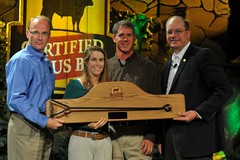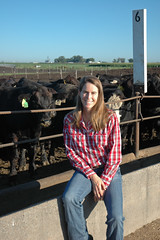The Fall Run—In July?
Last fall I wrote a post entitled “The Fall Run” explaining the typical busy season at the feed yard during the fall months. This is the normal time period when Nebraska cattle destined for harvest are moved off of grass pastures and into feed yards as the weather changes and the grass stops growing. At this time of the year, it becomes important to save the remaining grass in pastures for the breeding herds in our state. If you missed this post last fall, be sure to click here and read as it contains necessary background information relative to this series of “drought” posts…
https://feedyardfoodie.wordpress.com/2011/10/06/the-fall-run/
This summer has been anything but typical. While April brought relatively normal rainfall, May was dry, and June and July were marked by extremely hot temperatures and limited rainfall across the state. The result of this combination is a tremendous scarcity of grass for grazing.

Some yearling heifers on a near-by ranch in Central Nebraska. This was in early May and the cattle were being feed out of a feed bunk on the ranch “waiting for rain”…The rains never came so they shipped to my feed yard instead of going to grass.
This shift in the weather was unexpected because for the last several years Nebraska has been blessed with ample moisture and a bountiful supply of grass in our pastures. A Rancher who has a cow/calf or breeding cattle herd, determines the number of animals that he raises relative to the amount of grass or feed that Mother Nature provides for him.

This picture was taken last summer (2011) at AL Ranch when the grass was plentiful…Al is checking his cow/calf pairs while they graze on one of his grass pastures…
Raising cattle carries an enormous responsibility for a rancher—a responsibility to both to the cattle and to the land. In order to remain sustainable in the long run, it is imperative that the proper balance of cattle relative to grass exists. Too much grass results in wasted resources, while too many cattle and a lack of grass results in grass pasture damage that will impair future years of growth.

In years of plentiful grass (like in 2011 when this picture was taken), we can graze more animals per acre. In years of drought and reduced moisture, this balance must change dramatically to protect the land…
In years of ample rain and grass supply, ranchers either increase the size of their herd and/or bale up the extra grass to use in the winter time. In years of drought, ranchers decrease the number of animals that graze their pastures to balance against the smaller amount of feed that Mother Nature provides. In addition, many times during a drought, ranchers must also purchase supplemental feed to continue to offer good nutritional care to their animals.

My two favorite blondes sitting on a grass hay bale…Putting extra grass up in “bales” allows them to be saved for use once Mother Nature no longer provides…
Most summers, my cattle feed yard is pretty quiet as the majority of Nebraska’s cattle herd thrives on the grass that typically grows from June to August. This is a time for my crew and I to complete repairs, take vacation, and prepare for the coming Fall Run. This summer has been anything but typical…

Today the hills of Nebraska are brown…Our valley by the Platte River looks better than these hills in west-central Nebraska because we have picked up a few rains recently.
When ranchers are faced with a limited supply of grass, they must find a way to best use the feed that they have. One of the easiest ways to relieve the burden on a depleted grass supply is to move the non-breeding animals to a feed yard. This saves their increasingly scarce feed resources for the breeding herd.

Helping Mama to unload cattle this summer as the animals were taken off of depleted grass pastures and sent to the feed yard in search of something to eat…
In other words, all of the animals that will not enter the breeding herds are sent to feed yards earlier than normal to relieve the pressure on grass pastures. All of a sudden, the Fall Run happens in July instead of October which equates to a busy summer instead of a quiet one…
I value the relationships that I have with my rancher partners—I empathize with their challenges and want to do everything that I can to help them save their livelihood and their resources. As a result, I have already received most of the yearlings that I would normally place in the late summer / early fall—I also have only one more set of fall born calves to receive (they will ship next week to me)—In addition, I am already coordinating with my ranchers to figure out the best way to handle the spring born calves that normally ship to my feed yard in October and November. These animals may come as early as August or September because of the need to save grass for the Mama cows.

Mike and Peggy, ranchers from near Halsey Nebraska, pictured near their steers being finished at the feed yard. We have worked together for nearly a decade to provide all of you with high quality beef…
This year is a prime example of how Mother Nature can change even the best laid plans…In my fifteen years at the feed yard, this is the first Fall Run that I have ever experienced in July and August!





























